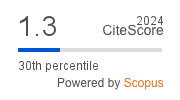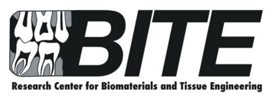Effect of 17% ethylenediaminetetraacetic acid and silver citrate on sealer resin penetration in the apical third
Downloads
Background: Endodontic sealers limit bacteria growth and clean the smear layer of the root canal. Biocompatible irrigants silver citrate and ethylenediaminetetraacetic acid (EDTA) have a chelating agent that increases sealer penetration in dentinal tubules. Purpose: This study aims to investigate the final irrigation difference in epoxy resin and bioceramic sealer penetration into dentinal tubules at the apical third. Methods: A total of 30 extracted mandibular premolars were split into six groups; three received epoxy resin sealer and three received bioceramic resin with aquadest, silver citrate (BioAKT) or EDTA 17% irrigation. A confocal laser scanning microscope estimated sealer penetration in dentinal tubules. For quantitative data analysis, Olympus Fluoview ver.4.2a was used. Results: Silver citrate final irrigation with bioceramic resin sealer had the highest dentinal tubular penetration (24%; 1,431 µm), followed by EDTA 17% (20%; 1,202 µm), aquadest (16.3%; 969 µm), EDTA 17% with epoxy resin (15.8%; 938 µm, 14%; 803 µm), and distilled water (10%; 584 µm). Significant differences existed in all groups (p = 0.001). Epoxy resin sealer penetration into dentinal tubules was similar between final irrigants (p = 0.257) and bioceramic resin groups (p = 0.658). Conclusion: Silver citrate (BioAKT), a bioceramic resin sealer-based final irrigation solution, penetrates dentinal tubules better for endodontic therapy.
Downloads
Johnson WT, Kulild JC. Obturation of the cleaned and shaped root canal system. In: Hargreaves KM, Cohen S, editors. Cohen's pathways of the pulp. 10th ed. Elsevier; 2011. p. 349–88. doi: https://doi.org/10.1016/B978-0-323-06489-7.00010-2
Jaju S, Jaju PP. Newer root canal irrigants in horizon: a review. Int J Dent. 2011; 2011: 851359. doi: https://doi.org/10.1155/2011/851359
Rahmatillah R, Erlita I, Maglenda B. Effect of different final irrigation solutions on push-out bond strength of root canal filling material. Dent J. 2020; 53(4): 181–6. doi: https://doi.org/10.20473/j.djmkg.v53.i4.p181-186
Al Shehadat S. Smear layer in endodontics: role and management. J Clin Dent Oral Heal. 2017; 1(1): 1–2. doi: https://doi.org/10.35841/oral-health.1.1.1-2
Yoo Y-J, Baek S-H, Kum K-Y, Shon W-J, Woo K-M, Lee W. Dynamic intratubular biomineralization following root canal obturation with pozzolan-based mineral trioxide aggregate sealer cement. Scanning. 2016; 38(1): 50–6. doi: https://doi.org/10.1002/sca.21240
Carvalho NK, Prado MC, Senna PM, Neves AA, Souza EM, Fidel SR, Sassone LM, Silva EJNL. Do smear-layer removal agents affect the push-out bond strength of calcium silicate-based endodontic sealers? Int Endod J. 2017; 50(6): 612–9. doi: https://doi.org/10.1111/iej.12662
Dioguardi M, Gioia G Di, Illuzzi G, Laneve E, Cocco A, Troiano G. Endodontic irrigants: Different methods to improve efficacy and related problems. Eur J Dent. 2018; 12(3): 459–66. doi: https://doi.org/10.4103/ejd.ejd_56_18
Susila A, Minu J. Activated irrigation vs. conventional non-activated irrigation in endodontics - A systematic review. Eur Endod J. 2019; 4(3): 96–110. doi: https://doi.org/10.14744/eej.2019.80774
Peeters HH, Judith ET, Suardita K, Mooduto L. Visualization of bubbles generation of electrical-driven EndoActivator tips during solutions activation in a root canal model and a modified extracted tooth: A pilot study. Dent J. 2022; 55(2): 71–5. doi: https://doi.org/10.20473/j.djmkg.v55.i2.p71-75
Mulyawati E, Marsetyawan HNES, Sunarintyas S, Handajani J. Sifat fisik hidroksiapatit sintesis kalsit sebagai bahan pengisi pada sealer saluran akar resin epoxy (Physical properties of calcite synthesized hydroxyapatite as the filler of epoxy-resin-based root canal sealer). Dent J. 2013; 46(4): 207–12. doi: https://doi.org/10.20473/j.djmkg.v46.i4.p207-212
Saed SM, Ashley MP, Darcey J. Root perforations: aetiology, management strategies and outcomes. The hole truth. Br Dent J. 2016; 220(4): 171–80. doi: https://doi.org/10.1038/sj.bdj.2016.132
Gulabivala K, Ng YL. Factors that affect the outcomes of root canal treatment and retreatment”A reframing of the principles. Int Endod J. 2023; 56(S2): 82–115. doi: https://doi.org/10.1111/iej.13897
Razumova S, Brago A, Serebrov D, Barakat H, Kozlova Y, Howijieh A, Guryeva Z, Enina Y, Troitskiy V. The application of nano silver argitos as a final root canal irrigation for the treatment of pulpitis and apical oeriodontitis. In vitro study. Nanomaterials. 2022; 12(2): 248. doi: https://doi.org/10.3390/nano12020248
Tonini R, Giovarruscio M, Gorni F, Ionescu A, Brambilla E, Mikhailovna IM, Luzi A, Maciel Pires P, Sauro S. In vitro evaluation of antibacterial properties and smear layer removal/sealer penetration of a novel silver-citrate root canal irrigant. Materials (Basel). 2020; 13(1): 194. doi: https://doi.org/10.3390/ma13010194
Meng Q, Chen Y, Ni K, Li Y, Li X, Meng J, Chen L, Mei ML. The effect of different ferrule heights and crown-to-root ratios on fracture resistance of endodontically-treated mandibular premolars restored with fiber post or cast metal post system: an in vitro study. BMC Oral Health. 2023; 23(1): 360. doi: https://doi.org/10.1186/s12903-023-03053-4
Uzunoglu-Özyürek E, Karaaslan H, Türker SA, Özçelik B. Influence of size and insertion depth of irrigation needle on debris extrusion and sealer penetration. Restor Dent Endod. 2018; 43(1): e2. doi: https://doi.org/10.5395/rde.2018.43.e2
Bao P, Shen Y, Lin J, Haapasalo M. In vitro efficacy of XP-endo finisher with 2 different protocols on biofilm removal from apical root canals. J Endod. 2017; 43(2): 321–5. doi: https://doi.org/10.1016/j.joen.2016.09.021
Uzunoglu-Özyürek E, Erdoğan Ö, Aktemur Türker S. Effect of calcium hydroxide dressing on the dentinal tubule penetration of 2 different root canal sealers: A confocal laser scanning microscopic study. J Endod. 2018; 44(6): 1018–23. doi: https://doi.org/10.1016/j.joen.2018.02.016
Ernani E, Abidin TM, Indra I. Experimental comparative study and fracture resistance simulation with irrigation solution of 0.2% chitosan, 2.5% NaOCl and 17% EDTA. Dent J. 2015; 48(3): 154–8. doi: https://doi.org/10.20473/j.djmkg.v48.i3.p154-158
Jitumori RT, Bittencourt BF, Reis A, Gomes JC, Gomes GM. Effect of root canal irrigants on fiber post bonding using self-adhesive composite cements. J Adhes Dent. 2019; 21(6): 537–44. doi: https://doi.org/10.3290/j.jad.a43609
Generali L, Bertoldi C, Bidossi A, Cassinelli C, Morra M, Del Fabbro M, Savadori P, Ballal NV, Giardino L. Evaluation of cytotoxicity and antibacterial activity of a new class of silver citrate-based compounds as endodontic irrigants. Materials (Basel). 2020; 13(21): 5019. doi: https://doi.org/10.3390/ma13215019
Eid D, Medioni E, De-Deus G, Khalil I, Naaman A, Zogheib C. Impact of warm vertical compaction on the sealing ability of calcium silicate-based sealers: A confocal microscopic evaluation. Materials (Basel). 2021; 14(2): 372. doi: https://doi.org/10.3390/ma14020372
Chitra S, Chandran R, Ramadoss R, Durgalakshmi D, Subramanian B. Unravelling the effects of ibuprofen-acetaminophen infused copper-bioglass towards the creation of root canal sealant. Biomed Mater. 2022; 17(3): 035001. doi: https://doi.org/10.1088/1748-605X/ac5b83
Jeong JW, DeGraft-Johnson A, Dorn SO, Di Fiore PM. Dentinal tubule penetration of a calcium silicate–based root canal sealer with different obturation methods. J Endod. 2017; 43(4): 633–7. doi: https://doi.org/10.1016/j.joen.2016.11.023
Mohammadi Z, Shalavi S, Jafarzadeh H. Ethylenediaminetetraacetic acid in endodontics. Eur J Dent. 2013; 7(S1): S135–42. doi: https://doi.org/10.4103/1305-7456.119091
Güzel C, Uzunoglu E, Dogan Buzoglu H. Effect of low–surface tension EDTA solutions on the bond strength of resin-based sealer to young and old root canal dentin. J Endod. 2018; 44(3): 485–8. doi: https://doi.org/10.1016/j.joen.2017.09.007
Giardino L, Andrade FB de, Beltrami R. Antimicrobial effect and surface tension of some chelating solutions with added surfactants. Braz Dent J. 2016; 27(5): 584–8. doi: https://doi.org/10.1590/0103-6440201600985
Banci H, Strazzi-Sahyon H, Duarte M, Cintra L, Gomes-Filho J, Chalub L, Berton S, de Oliveira V, dos Santos P, Sivieri-Araujo G. Influence of photodynamic therapy on bond strength and adhesive interface morphology of MTA based root canal sealer to different thirds of intraradicular dentin. Photodiagnosis Photodyn Ther. 2020; 32: 102031. doi: https://doi.org/10.1016/j.pdpdt.2020.102031
Christopher SR, Mathai V, Nair RS, Angelo JMC. The effect of three different antioxidants on the dentinal tubular penetration of Resilon and Real Seal SE on sodium hypochlorite-treated root canal dentin: An in vitro study. J Conserv Dent. 2016; 19(2): 161–5. doi: https://doi.org/10.4103/0972-0707.178702
Sonu K, Girish T, Ponnappa K, Kishan K, Thameem P. "Comparative evaluation of dentinal penetration of three different endodontic sealers with and without smear layer removal” - Scanning electron microscopic study. Saudi Endod J. 2016; 6(1): 16. doi: https://doi.org/10.4103/1658-5984.171996
Pereira TC, Boutsioukis C, Dijkstra RJB, Petridis X, Versluis M, de Andrade FB, van de Meer WJ, Sharma PK, van der Sluis LWM, So MVR. Biofilm removal from a simulated isthmus and lateral canal during syringe irrigation at various flow rates: a combined experimental and Computational Fluid Dynamics approach. Int Endod J. 2021; 54(3): 427–38. doi: https://doi.org/10.1111/iej.13420
Silva EJNL, Cardoso ML, Rodrigues JP, De"Deus G, Fidalgo TK da S. Solubility of bioceramic" and epoxy resin"based root canal sealers: A systematic review and meta"analysis. Aust Endod J. 2021; 47(3): 690–702. doi: https://doi.org/10.1111/aej.12487
AL-Haddad A, Che Ab Aziz ZA. Bioceramic-based root canal sealers: A review. Int J Biomater. 2016; 2016: 9753210. doi: https://doi.org/10.1155/2016/9753210
Asawaworarit W, Pinyosopon T, Kijsamanmith K. Comparison of apical sealing ability of bioceramic sealer and epoxy resin-based sealer using the fluid filtration technique and scanning electron microscopy. J Dent Sci. 2020; 15(2): 186–92. doi: https://doi.org/10.1016/j.jds.2019.09.010
Copyright (c) 2024 Dental Journal

This work is licensed under a Creative Commons Attribution-ShareAlike 4.0 International License.
- Every manuscript submitted to must observe the policy and terms set by the Dental Journal (Majalah Kedokteran Gigi).
- Publication rights to manuscript content published by the Dental Journal (Majalah Kedokteran Gigi) is owned by the journal with the consent and approval of the author(s) concerned.
- Full texts of electronically published manuscripts can be accessed free of charge and used according to the license shown below.
- The Dental Journal (Majalah Kedokteran Gigi) is licensed under a Creative Commons Attribution-ShareAlike 4.0 International License

















